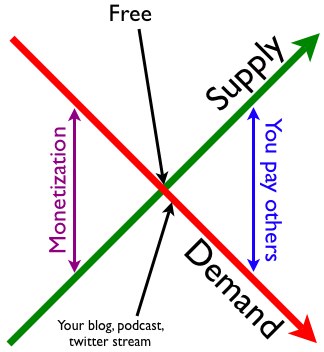How To Monetize Your Social Media Outlet
In a variation of a Financial Aid Podcast blog post this morning, here’s a brief economics 101 explanation of how you can monetize your blog, podcast, Twitter lifestream, or other social media outlet.
Economics 101
Supply and demand are inversely related. When demand exceeds supply, you have to pay others to take your stuff. When supply exceeds demand, other people pay you for your stuff. Value comes from demand. Here’s a simple monetization chart:
If your social media outlet is in high demand, you can get paid for it. If your social media outlet is not in high demand, you have to pay others to take your stuff. If supply and demand are in equilibrium, you’re at totally free.
This is why advertising is the main method of monetization for most social media. Your social media outlet in and of itself has very little value, sorry to say. What has value is your audience. They’re the commodity that you have to sell, and you do sell them, whether or not you want to believe you do. You can sell the actual audience in the form of renting or selling an email list, or more likely, you sell access to your audience in the form of endorsement, sponsorship, or ads. Your audience is the value to the advertiser, and in turn, your content is the value for your audience.
See the entry on the chart where it says your blog, podcast, and twitter stream? See how it’s actually in the you pay others section? It’s true. Statistically, you pay others for your content. You may say that you’re blogging for free or giving away your content, but the reality is that you’re paying others, in hosting fees, bandwidth, in domain name purchases, in your time and energy to create and market your content.
You’re paying others.
Social Media Metrics That Matter
How do you know when you’ve become a true social media success?
When everyone pays you.
Advertisers pay for access to your audience. Your audience pays for access to your content – perhaps in cash, perhaps in inbound links, perhaps in word of mouth marketing on your behalf. Major media outlets pay in time and energy to cover what you’re talking about.
Most important of all, checks arrive in the mail or by direct deposit that are sufficiently large enough for you to meet your expenses and then some. At the end of the day, whether or not you can afford to eat and put a roof over your head is the only metric that matters.
How To Monetize
How do you get there? Back to the chart.
You’re fighting an uphill battle if you think you can reduce overall supply, so you have to be a specialist, an expert in something that is in short supply. Ideally, it should be something in short supply but high demand – like insider stock tips, or financial aid information.
As I’ve said in the past, I’m not a podcaster. I’m a financial aid expert who has a podcast.
So let’s assume you’ve got basic supply solved – you’ve found a niche, a place where there’s market demand for your supply. Then it’s up to you to market your content. Marketing, as I’ve said in the past, is about sharing ideas, which is a kind and gentle way of saying marketing is creating demand for your ideas.
Marketing is the creating of demand for your supply.
The more you effectively market, the more demand there will be for your content. That in turn will drive audience growth, which you can monetize directly (audience pays) or indirectly (advertisers pay), or both.
As my friend Whitney Hoffman says, you can’t outrun Adam Smith and the laws of economics. If you’re currently being paid for social media, enjoy that you are, and realize that if your monetization model doesn’t conform to the basic laws of supply and demand, your model is not sustainable and sooner or later, the money will stop.
Did you enjoy this blog post? If so, please subscribe right now!
Get this and other great articles from the source at www.ChristopherSPenn.com




Leave a Reply